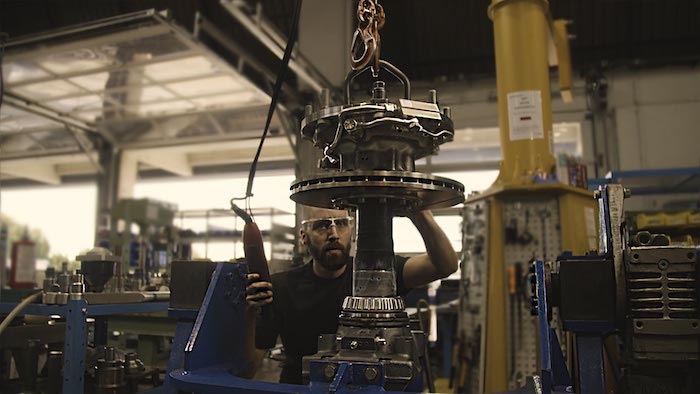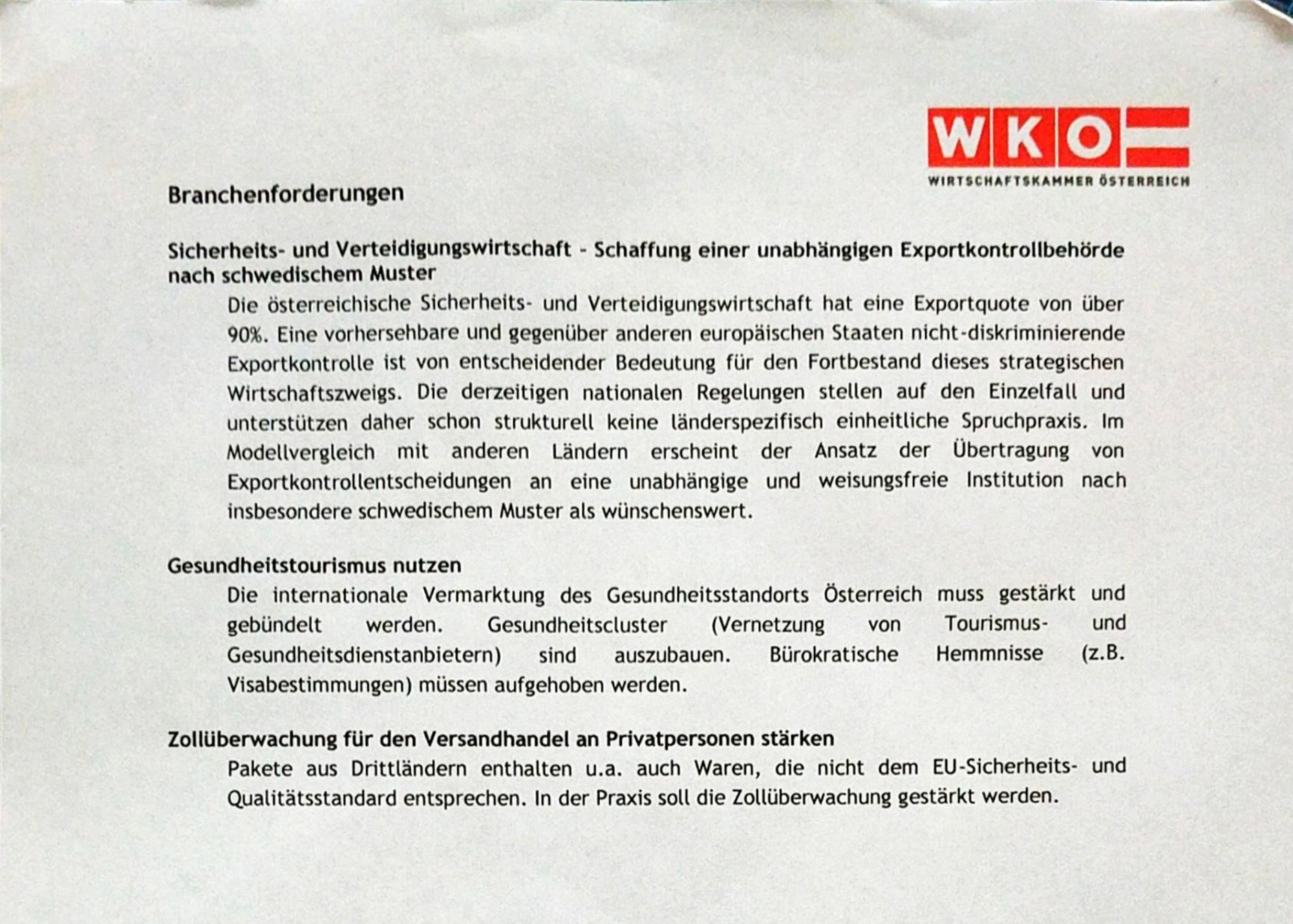Get the weekly SPARTANAT newsletter.
Your bonus: the free E-Book from SPARTANAT.

Armament (8): Trade with security - exports amounting to 638 million euros per year.
Welcome to my website! Here you can find information about our products and services. Feel free to contact us for any inquiries.

For more information, visit our about page and explore our FAQ section.
When Gerhard Unterganschnigg says or does something, he is certain of his decision, having thought it through carefully beforehand. Just like eleven years ago, when the athletic entrepreneur, together with a partner, took over the globally esteemed but economically struggling weapons manufacturer Steyr-Mannlicher.
Today, Unterganschnigg sits at the conference table of his Vienna office in Döbling, speaking in precisely formulated sentences about how the Republic of Austria regulates his daily business operations. Or hinders them. Because: The Austrian War Materials Act (and its interpretation) is globally seen as "one of the strictest, if not the strictest" export regime for military goods worldwide.
Disadvantaged compared to other EU countries?
The choice of words always depends on the respective standpoint. In any case, Unterganschnigg (see short video below) says that on several occasions, business deals have slipped through his fingers without any fault of his own.
While the sale of weapons produced at the Kleinraming border in Lower Austria and Upper Austria has been going better since the acquisition. But it could be even better. Much better, as Unterganschnigg and a good part of his industry colleagues from the defense industry believe. The 50-year-old says: Austrian laws hinder the progress of domestic companies, disadvantage them compared to European competitors, and ultimately jeopardize the location. Unterganschnigg puts it this way:
The Steyr-Mannlicher co-owner is not alone in his criticism. The entire industry sees this problem. "The industry" is a branch of the Economic Chamber. Externally, it appears as the Working Group for Security and Economy, ASW for short. After the last National Council elections, ASW addressed a broad but non-public paper to key decision-makers in politics (see the following facsimile). Quote: "Predictable and non-discriminatory export control compared to other European states is of crucial importance for the survival of this strategic sector." And further: For the future, they wish for an arms export authority independent of political influence, following the Swedish model. That was in the fall of 2017.
Our research has revealed that two years earlier, internal discussions had taken place on the subject. As part of market observation in Asia, it was noted that Austria apparently lagged behind other EU countries.
The appeal from the industry sounds dramatic. But can the claimed difficult situation be backed up with data? At first glance, it cannot.
Our research team has, for the first time, managed to make all the machine-readable arms export reports of the member states to the European Union and analyze them. For this publication, we focused on Austria. Vienna first reported figures on the exports of military goods to foreign countries in 2002. Result: Since then (43.8 million euros), annual exports have increased almost fifteenfold until the last available reporting year (2016: 638.5 million euros). In total, military goods worth 4.8 billion euros have crossed the border since then.
In relation to the "export world champion" Germany, especially the recent numbers are impressive. While Berlin did not report its data directly to Brussels, it documented 6.8 billion euros in exported military goods in its own arms control report.
Even more impressive are the figures for the export of know-how and production rights. This refers to the sale of licenses for manufacturing by a manufacturer in the target country. Such licenses are sold for high sums. In Austria, the revenues from license sales far exceed those from actual arms exports by a wide margin.
In 2016 alone (the data for which was released by the EU in the spring of 2018), nearly four billion euros are recorded in the statistics (see the following graph). This corresponds to an almost twentyfold increase since the first corresponding report for the year 1998. The total volume since then: 22.6 billion euros.
Can an export regulatory that has allowed average annual growth rates of 6.4 (only domestically produced goods) and 14.9 percent (license sales) according to EU data over the past one and a half decades be one of the strictest in the world?
Yes. Because it is primarily the opaque and unreliable framework conditions that make it difficult for Austrian companies. This can be roughly described in three points.
1. The Silent Treatment on Arms Exports
Anyone in Austria who wants to learn more about the government's actions in the field of arms exports will face a wall of silence in the government quarter of Vienna's city center. The Ministry of the Interior (responsible for war materials) and the Ministry of Economy (responsible for military and so-called dual-use goods) that issue the necessary permits do not provide public data. Countries like Germany, known for exporting a large amount of military goods (keyword: export world champion), do so.
Even the material that Statistik Austria receives from the government for its economic data has a large "G" (stands for "secrecy of results") in the line for "war weapons."
At least Vienna still adheres to the Common Position for the Control of the Export of Military Technology and Military Goods and reports this data to the European Union in an - as mentioned above - unreadable form.
What does this mean for companies? Often incomprehensible decisions about why a certain good from a specific manufacturer was allowed to be exported to a country while another manufacturer with a similar good was denied. Moreover, the lack of transparency allows for political influence behind the scenes (see point 2).
Rifles for India's Police? Impossible
One example:
In November 2008, Islamist terrorists carried out several coordinated attacks in Mumbai, India, killing 174 people. A special police unit subsequently concluded that the existing sniper rifles were outdated and unsuitable for such scenarios. And wanted to order a few of these weapons, precisely eight pieces, from Steyr-Mannlicher in Austria. But the Ministry of the Interior said no. Yet in the five years before, other handguns worth 330,000 euros had been delivered to India without any problems.
2. Political Influence
On paper, the decision to permit or prohibit the export of war material is made in Department 3 of the Legal Section of the Ministry of the Interior. There, according to the law, decisions are made at a bureaucratic level based on factual criteria. For "normal" military goods (which can also be weapons or weapon parts), the Ministry of Economy is responsible.
Insiders from both ministries, under the protection of anonymity, told us that politics always influences the decision-making process of granting export permits for war material. For example, when an export is at least difficult due to the current human rights situation in the target country, but economic (such as jobs) or strategic (security situation) interests of the Republic stand in opposition. The intention of such influences is always to maximize the discretionary power for the decision.
Another indication of political influence was mentioned to us by an industry informant. During a confidential meeting, he explained to us with several examples that before the National Council elections in the fall of 2017 and in the post-election period (government negotiations), "no authorizations were to be obtained at all." Even existing service agreements with foreign customers could not be fulfilled at that time. "To the delight of competitors from neighboring EU countries."
3. Lengthy and Uncertain Processes
Those wishing to export war material, defense or so-called dual-use goods from Austria therefore require the corresponding authorization. However, obtaining this can take far too long and is to be understood with reservations from the perspective of a competing company. An example:
Suppose you produce components for use in an electronic fire control system for - for example - grenade launchers in your company. And suppose you learn that there is demand for this in - for example - Saudi Arabia. In such a case, it is highly likely that you will come into contact with Berndt Wesiak.
Fear Until the End
The 53-year-old Austrian has handled a series of arms exports as a broker and advisor to manufacturers and end customers over the past years. He says that the producer is constantly at risk of having an already issued export license revoked. As the former Austrian Armed Forces officer told us during a meeting on the outskirts of Vienna, this can happen at any time and without stating reasons. "Especially small companies can suffer greatly if the goods have already been produced but have not left the country yet."
He himself experienced something like this after his time in the military and before founding his company "Pro Oriente Consultationes" at a well-known weapons manufacturer. At that time, it was about a shipment of war material to the Arabian Peninsula. In such cases, the damage to reputation is much greater than the economic loss. Wesiak: "One of the highest values for buyers of military goods is supply security. If the manufacturer cannot deliver, customers in this segment have no understanding for their problems. Especially Arabs."
Incidentally, Wesiak does not believe that the Austrian export regime is overall too strict. However, he believes that the existing laws - possibly also for political reasons - are interpreted very selectively and not always comprehensibly. The United States is the most prominent example.
According to our data analysis, Austrian companies delivered military goods worth 2.1 billion euros to the USA since 2002. This makes the USA by far the most important destination country in this sector. The overwhelming majority of these, products worth 1.9 billion euros, were handguns.
Although EU data on Austrian arms exports does not indicate who produced and exported the goods, only two companies are essentially capable: Glock GmbH (pistols) and - to a much lesser extent - Steyr-Mannlicher (mainly assault rifles and sniper rifles). Both products are subject to approval for export.
"The refusal of the export itself is not a politically shaping instrument."-Heiko Borchert, Defense Policy Advisor
In connection with the alleged unpredictability of arms trade in the defense sector, we spoke with Heiko Borchert, a defense and technology consultant from Switzerland. Borchert has been working for many years, among other things, for armies in Central Europe, including the Austrian Armed Forces. In an interview, he told us that what is primarily lacking in Austria is a transparent and binding exchange of information between ministries and the economy. And once again mentioned (see the next clip) Sweden as an example:
The intention to take at least a small step is stated in the current government program.
SPARTANAT is the online magazine for Military News, Tactical Life, Gear & Reviews.
Send us your news: [email protected]
Ad
similar
Get the weekly SPARTANAT newsletter.
Your bonus: the free E-Book from SPARTANAT.




